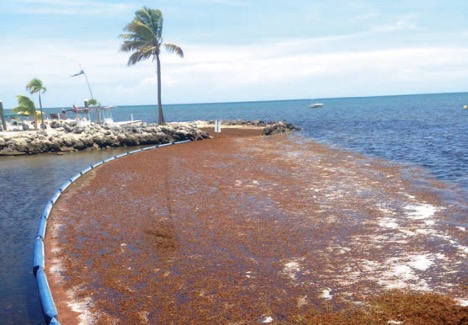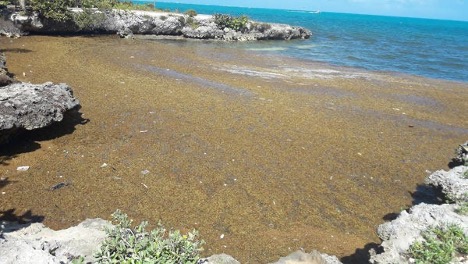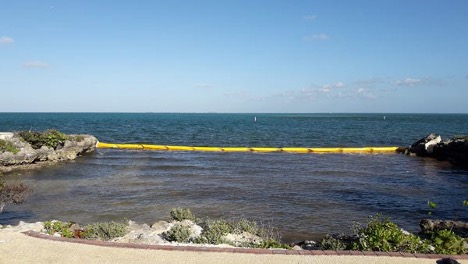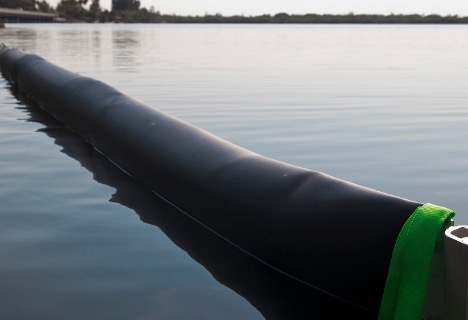Sargassum in the Caribbean Sea Increased by More Than 100% Since December

Throughout the upcoming months and into the summer, previously pristine beaches will become covered in groups of brown seaweed known as Sargassum. These large masses of Sargassum usually float out in the open sea and then wash up on beaches ultimately hurting tourism, navigation, commercial fishing, and ocean-based businesses. Prolonged exposure to the decomposing seaweed can cause headaches, nausea, asthma problems, and eye irritation.
Despite these issues, Sargassum serves a vital role. It is important for aquatic life, including species of fish, turtle, crab, and birds. They hide in and under the weeds from bigger predatory fish and forage it for nutrients. While it is environmentally illegal to remove the seaweed in some coastal areas because of this, what can be done to control it?
Sargassum Outlook for 2022
As rafts of Sargassum creep toward shorelines, it’s only natural to wonder how much will be coming in the next few months.
The University of South Florida Optical Oceanography Lab’s Satellite-based Sargassum Watch System (SaWS) recently released its Sargassum outlook bulletin for the upcoming months. The bulletin confirmed a dramatic Sargassum increase beaching in the Central West Atlantic Ocean and the Caribbean Sea. Compared to previous bloom years, the total increase this January (1.7 M tons to 4.0 M tons) ranks the fourth highest since 2011. This unusual and large increase may suggest another major Sargassum year to prepare for.
The exact amount of Sargassum present on beaches will be determined by ocean tides, circulations, and winds.
A Never-Ending Battle: Ineffective Methods of Sargassum Control
A common method of Sargassum control is to remove it directly from the beaches, but this has its problems. Simply removing the Sargassum from the Caribbean shorelines, either by hand or with costly equipment that needs to be maintained, is a tedious, short-term task, rather than a long-term solution.
When you remove it from the beach, you must have a designated area, away from the public, where you can dispose of it due to its corrosive, toxic nature when it decomposes. Not to mention, this may cause problems within aquatic ecosystems with species that rely on Sargassum as well.
Rotting Sargassum Problems:
- Emits Toxic and Corrosive Gas
- Causes Hydrogen Sulfide Poisoning with Flulike Symptoms
- Attracts Invasive Insects
- Destabilizes Beaches – Causing Erosion
- Contributes to Copper Erosion
- Damages Plumbing and Electrical Equipment
No sooner has the seaweed been removed from the beach than the next batch washes ashore — starting the process all over again.
The Ideal Solution: Stop Sargassum from Coming Onshore with Our Sargassum Debris Boom

Unlike beach based Sargassum clean-up methods, our Sargassum Debris Boom is strongly built, diverts Sargassum away from the beach, (or collects it to a particular area for removal) and can withstand extended use in many aquatic locations. Any barrier system should be monitored, maintained, and may require occasional repositioning or re-tensioning of the anchoring to ensure the boom design stays effective. The boom work in calm or moving water, varying tidal conditions, and are built to withstand UV-exposure and ambient temperatures.
Made with a robust and flexible material, our boom float along the surface of the water to effectively contain seaweed and prevent the spread of material to new locations. As Sargassum is contained in the barrier, the beach stays clean, and the need for widespread cleanup is eliminated. They are commonly used in marinas, ports, naval yards, repair areas, and docks.
Contain Sargassum Blooms in Multiple Ways
- Deflection: Utilize the Sargassum Debris Boom to keep Sargassum off the beach. This is particularly useful in coves or protected beaches. The containment boom floats on the surface of the water, allowing fish, sea turtles, and other marine life to pass underneath it.
- Diversion: Use the Sargassum Debris Boom to deflect Sargassum from hotel and resort beaches to nearby beaches where it can be collected.
- Containment: Use the Sargassum Debris Boom to gather Sargassum in open water where it can be collected.
For Long-Term Use
If you require a long-term containment solution, we also offer our Permanent Seaweed Barrier. This barrier is often used by resorts and hotels with more protected bays. Regardless of the boom product selected for your location, all floating barrier systems should be removed prior to a significant storm event.

Unique Problems Call for Unique Solutions
GEI Works not only manufactures unique product solutions for environmental issues, but we are also continually learning about new methods and procedures for mitigating disasters like the Sargassum Bloom of 2018.
Clean beaches matter. In 2015, when the last record bloom struck the Caribbean, we sent a team to the Dominican Republic to learn more about the invasive seaweed while our production team worked overtime to construct a solution that could be immediately deployed. When Sargassum is overwhelming your beach, immediate action is needed. GEI Works can quickly mobilize to get the fast answers that are needed.
We have worked with many beach resorts and communities in a variety of coastal locations. We help them with their emergency Sargassum problems, providing the fast response they need to get the Sargassum under control.
Areas We Have Helped Contain Sargassum Blooms
- Antigua
- Turks & Caicos
- British Virgin Islands
- Grand Cayman
- Dominican Republic
- Belize
- Florida Keys
- New York
- Dania Beach
- Many Others in the U.S. and the Caribbean

Your project’s budget, specifications, requirements, and environmental conditions all factor into the specific Sargassum solution that’s right for you. That’s why we work with each client individually and consult global experts to help find the right solution for your needs. If you’re experiencing issues with Sargassum, we are interested in hearing from you.
Contact Our Team at GEI Works to discuss your project and develop a solution.
geiworks.com | (772) 646–0597 | info@geiworks.com




